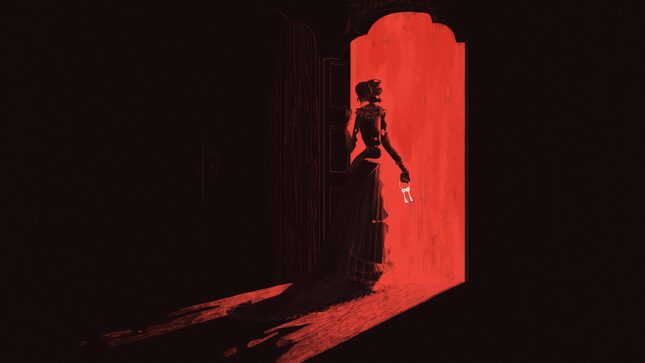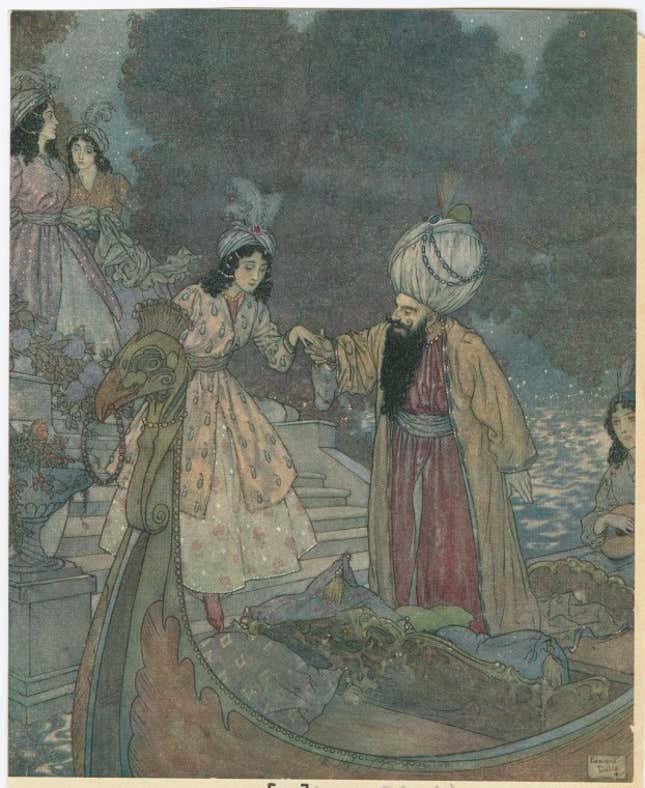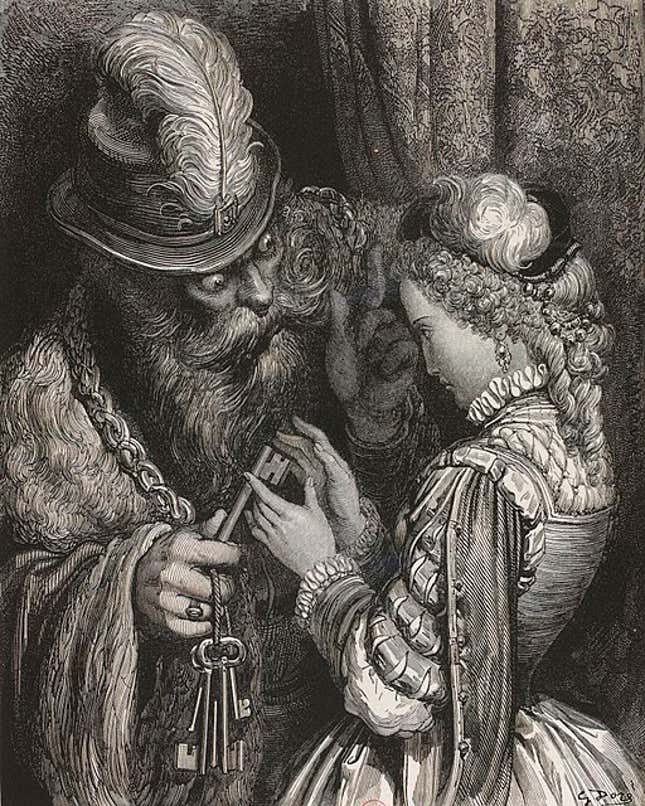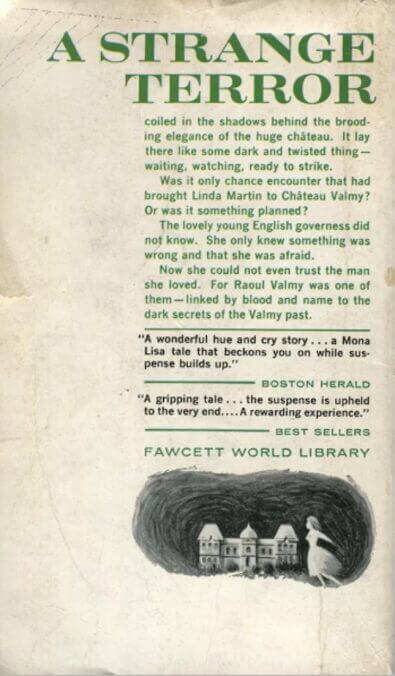Something Is Wrong in This House: How Bluebeard Became the Definitive Fairy Tale of Our Era
In DepthIn Depth
Image: Chelsea Beck
A door that locks without anyone touching it, rendering escape impossible. A large man who overpowers, beast-like. A man wears a mask of virtue that he removes behind closed doors. These striking and grotesque images could have sprung from fairy tales, but they didn’t—they’re from real testimonies by real women, over the last year of reckoning. Yet, there’s a kinship between so many #MeToo accounts and the original grimmer fairy tales that came before the 20th century.
In her short history of fairy tales, Marina Warner writes that the genre is remarkable for its straightforwardness: “This is as it is, as it happened; the tale is as it is, no more no less.” What has the past year been if not a parade of awful stories, delivered in clinical and straight-faced reporter speak? What is a whisper network but a series of people serving as each other’s fairy godmother? A father whose lusts are revealed to be perverse and violent describes both the Charles Perrault tale “Donkey Skin” and, in a sense, the man who was formerly “America’s dad,” Bill Cosby. Rape, assault, sexual harassment—they’re the stuff of fairy tales, fitting comfortably alongside the child-eating wolves and witches.
But of all the echoes of fairy tales, the loudest of all is the story of Bluebeard. The character, named for the color of his beard, originally appeared in Charles Perrault’s 1697 compilation Histoires ou contes du temps passe. Perrault tells the story of a rich, ugly man with a blue beard across his face who woos a young woman with a succession of parties at his elaborate home. The woman, often named Fatima, becomes convinced he can’t be quite so bad as a husband and consents to marriage. He gives her two keys, one of which unlocks all his treasures and she is free to use as she likes. The other, however, unlocks a small room that’s absolutely forbidden.
Of course, she unlocks the small room that’s absolutely forbidden. Perrault writes (via Norton’s The Great Fairy Tale Tradition):
At first she could discern nothing, the windows being closed, but after a short time she began to perceive that the floor was all covered with clotted blood that reflected the dead bodies of several women suspended from the walls. These were all the wives of Bluebeard, who had cut their throats one after the other.
She drops the key in her horror; when she tries to cover her tracks, she learns the key is enchanted and reveals the blood to her wife-murdering husband. “You wanted to enter the room! Well, madame, you shall enter it, and you shall take your place among the ladies you saw there,” Bluebeard thunders. The woman is saved from the fate of her predecessors, delaying her murder long enough for her brothers to ride to her rescue.

In the original telling, Perrault puts the fault at the heroine’s door, appending a moral warning against the dangers of a woman’s excessive curiosity: “Curiosity, in spite of its appeal, May often cost a horrendous deal. A thousand new cases arise each day, With due respect, oh ladies, the thrill is slight: As soon as you quench it, it goes away. In truth, the price one pays is never right.” Alternatively, it doesn’t take a Freudian to see lurking anxiety about marriage as the initiation into adult sexuality and the staggering rates of death in childbirth before the medical advances of the 19th century. But the most obvious lesson is quite simple: Before you climb onto the back of Prince Charming’s steed, remember that sometimes men murder their wives.
Bluebeard, though, has long been represented in a vastly different manner than the suitors of Cinderella or Snow White. “Well out of fashion in the court of the Sun King,” Warner explains in From the Beast to the Blonde, “the beard of Perrault’s villain betokened an outsider, a libertine, a ruffian.” Almost immediately, illustrators and retellers began interpreting that to mean that Bluebeard must be an Ottoman or some sort of Eastern amalgam, giving the story wildly Orientalist illustrations and pushing the whole disquieting tale into the geographic and cultural distance. (“By the blueness of his protagonist’s beard, Perrault intensifies the frightfulness of his appearance: Bluebeard is represented as a man against nature,” Warner adds—either by dying it “like a luxurious Oriental,” or by producing such a wild mane without any help.) This despite a long folkloric tradition associating Bluebeard with the very real Gilles de Rais, a companion to Joan of Arc, who was hanged in the 15th century for the serial murders of children. Even with this possible reality available, interpreters have imagined Bluebeard as fundamentally foreign, while representing the more appealing fairy tale husbands as familiar, even local.
Bluebeard has always been part of the fairy tale canon, but has drifted to the margins as “fairy tale” has come to mean colloquially something more specific than the “wonder tales” of Perrault and the Grimms. A “Cinderella story” is a generic concept obvious to everyone; we do not have the equivalent for Bluebeard. When Prince Harry and Meghan Markle’s wedding was referred to as “fairy tale,” its meaning was apparent: an average girl turned princess living happily ever after with her prince. But unlike Cinderella, Bluebeard doesn’t lend itself to the Disney interpretation of the genre. A blood-smeared key and a string of dead wives stored in their own gore don’t make for little girl’s party decorations. Nor does it lend itself to the fanciful dress up of Disney femininity.

As the cultural context of Bluebeard has fallen away—childbirth is no longer so dangerous—it is the simple fact of violence against women—at the very least, menace in private spaces shielded from the eyes of outsiders—has come increasingly to the fore. In that form, a story of creeping unease, a sense that something is not right under one’s own roof, is everywhere we look.
The story of Bluebeard is central to gothic romance, haunting the halls of all those spooky houses that loom large in the popular imagination. Bluebeard reappears, for example, in Jane Eyre, which makes specific reference to the tale in creating its aura of eerie domestic wrongness: “I, by drift of groping, found the outlet from the attic, and proceeded to descend the narrow garret staircase,” Charlotte Bronte wrote in Jane’s voice. “I lingered in the long passage to which this led, separating the front and back rooms of the third storey: narrow, low, and dim, with only one little window at the far end, and looking, with its two rows of small black doors all shut, like a corridor in some Bluebeard’s castle.” It’s no coincidence that Rochester has a secret chamber where he stores away a secret wife. And rather than mounting a heroic rescue, her brother is stabbed for his fraternal troubles.
In turn, perhaps Jane Eyre’s most influential descendent in terms of 20th-century popular culture is Daphne du Maurier’s perpetually bestselling Rebecca, about a shy frump who marries a rich man and is carried off to his stately English home. Her Cinderella romance abruptly ends when she finds herself confronted at every turn with the lurid specter of his first wife Rebecca. She died under mysterious circumstances that everybody references but nobody seems willing to explain, leaving the heroine—who’s never named—to unravel the awful truth that her husband is the kind of man who murders his wives. But it’s okay, the reader may conclude, because Rebecca was far from perfect. She was vindictive, evil, and manipulative.
Of course, it isn’t okay—but though Du Maurier didn’t consider her book a romance, many readers did. (Speaking of #MeToo, Alfred Hitchcock’s adaptation tweaked the ending so that Maxim wanted to kill her, but she conveniently died in an accident.) Rebecca spawned an entire subgenre popular in the middle of the century—the modern gothic romance, often explicitly packaged as kin to Du Maurier’s novel. These are the books whose covers famously feature young women running away from looming houses.
In her landmark and incredibly named essay, “Somebody’s Trying to Kill Me and I Think It’s My Husband: The Modern Gothic,” critic Joanna Russ describes the type:
After a short prologue, this latter-day Jane Eyre forms a personal or professional connection with a older man, a dark, magnetic, powerful brooding sardonic Super-Male, who treats her brusquely, derogates her, scolds her, and otherwise shows anger or contempt for her. The Heroine is vehemently attracted to him and usually just as vehemently repelled or frightened—she is not sure of her feelings for him, his feelings for her, and whether he (1) loves her, (2), hates her, (3) is using her, or (4) is trying to kill her.;
Russ notes that these heroines are often incredible passive—she argues these are adventure stories written around protagonists whose ability to act is circumscribed by traditional gender roles. Instead, they enact a specific drama, the “Something Is Wrong In This House” morality play. Their defining characteristic is the heroine’s sense that something is dreadfully off; their prevailing mood is one of anxiety and dread. The heroine enters a situation—whether as a new wife or as a companion or nanny—where there’s a secret that is known to everyone but her. She is surrounded by characters who know that something is wrong, but their own agendas bind them to silence, so she’s never provided the full truth; instead, she’s left to fend for herself. Much like all the women who walked into rooms with Harvey Weinstein without knowing what the entire industry seemed simultaneously to know, occasionally reference obliquely, and ignore rather than act.

These books always engage with a specific fear: that someone you trust, who has more power than you, will hurt you behind closed doors. Sometimes that fear—for instance, in Mary Stewart’s Nine Coaches Waiting—is resolved by the heroine’s learning that her man is only peripherally involved in whatever domestic wrongness she’s detected, and not the villain. Sometimes—for instance, in Anya Seton’s Dragonwyck, for example—the heroine’s husband or fiancé is the villain, but there’s a kindly man just waiting for the opportunity to help her escape and claim her hand. There’s a way to see these stories as metaphors for erotic relief—of realizing that you’re in the hands of a man who’s not a villain, especially when the world is full of them. But at other times, particularly in the more cookie-cutter romanticized ripoffs of Rebecca, these gothic romances read as a kind of fictional excuse for violent behavior, the kind that often leads to murder.
As Russ suggests: “Something is trying to hurt me and tear me down—but I don’t know what it is. I suspect it’s my man, or men in general, but that’s an unthinkable thought.” There’s an element of flirting with danger only then to dismiss it; a scary story told in the dark, terrifying because it hints at truths.
Distance is essential in fiction. The fairy tale Bluebeard is happening somewhere over there, in the vague and mysterious East. Fairy tales are generally set a long time ago, in a land far, far away, but Bluebeard’s castle is even further. And the men in the midcentury gothic pulp romances are essentially aristocrats—something that most middle-class American women reading these paperbacks were never going to encounter in real life. Distance makes it possible to tell a story about what’s happening in your own house. Times Up, too, has expanded its work to arenas beyond the entertainment industry, but its creation was driven by celebrities—and what’s Hollywood but our own distant fairy tale landscape, half real, half imagined?
The more explicit romance novel killed off the spooky house paperbacks in the 1970s, their tropes dissipating into the wider category of fiction—though you can still see their influence in Christian Grey’s “red room of pain,” like blood on an enchanted key. But the story’s legacy shines most bright in the genre of true crime, which is largely consumed by women. Investigation Discovery is essentially a 24/7 cable destination dedicated to crime, and it’s among the most popular networks among women 25 to 54. See also the podcast “My Favorite Murder,” with its dedicated female fandom. There’s a similar dance here between recognition and distance—instead of happening elsewhere in a broader sense, these are literally, specifically stories that happened to other women.

Bluebeard has been running quietly through the culture like an underground river, the dark twin to Cinderella.
Over the years, Maria Tatar writes in her entry on the story in The Oxford Companion to Fairy Tales, “illustrators, commentators, and retellers alike seem to have fallen in line with Perrault’s view” that it’s a story about the dangers of female curiosity. If anything, they’ve laid it on thicker than Perrault, whom Warner points out in From the Beast to the Blonde, “was eager to espouse the woman’s cause.” Even the most retrograde of the gothic house novels knows better. Those heroines feel in their bones that something is wrong, and even if some aspect of their suspicions turns out to be wrong or even downright silly, they’ve usually recognized something.
The Weinstein revelations brought so many more awful stories to light; the last year has often felt like an endless hallway of doors swinging open, one after another, bloody chambers extending onward into the darkness forever. But how many of those stories had been long-rumored? How many women had already known, or at least suspected? It has often been the very concept of “private” that has kept these stories either shut away, or trapped in some shadow realm where they go understood but unacknowledged. Perhaps #MeToo’s biggest upheaval has been dragging these secrets down from the proverbial attic and laying them out in public; an insistence that the domestic home is no longer a place to hide grisly secrets. That confrontational insistence on witness is a profound violation of many traditional boundaries, and the source of so much anxiety about whether the movement has gone “too far.”
If there’s any comfort to be found in the last year, it’s in the confirmation that curiosity, suspicion, and gut feelings were hinting at a violent truth: Something is wrong in this house.